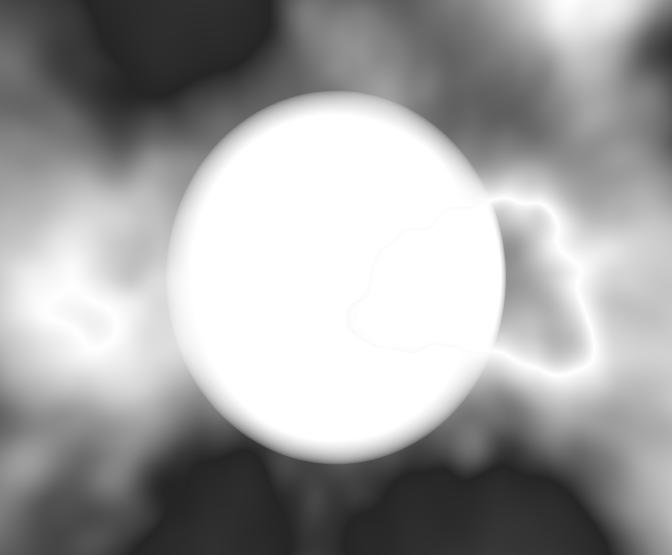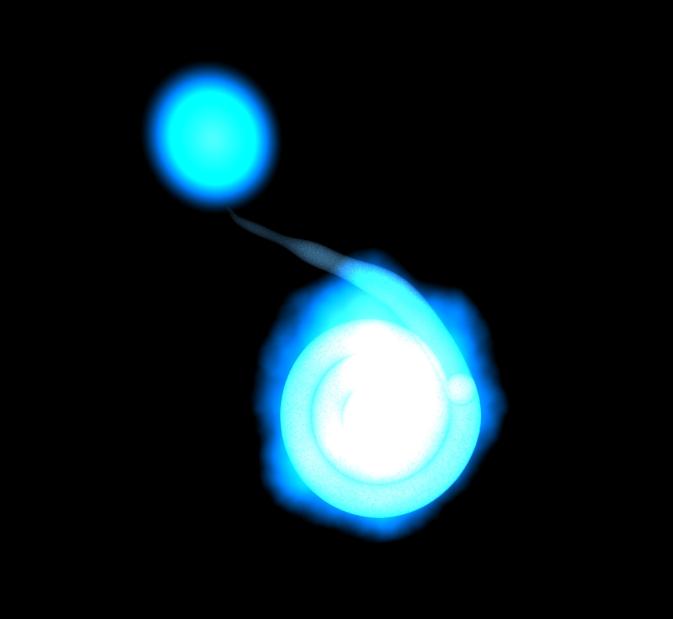Captain's log: galactic date 1034 7-14: Starstrider investigates an association of hot young giant stars.
These stars, of spectral classes O, B and A are hot blue-white main sequence giants. The O and B stars
only live for a few million or tens of million years, but the A stars live for about 400 million years. Thus,
these stars live very brief but energetic lives by stellar standards. We investigate a group of A stars.
These stars typically have tremendous angular momentum and spin very rapidly, especially when young.
The A star above is spinning at over 90% of the maximum velocity at which the centrifugal forces would rip
it apart! It is spinning on its axis once every 12.2 hours and this causes its equator to bulge, such that its
equatorial radius is 20% larger than its polar radius and the star appears elliptical. The bulging equator is
about 2000K cooler than the poles. The mean surface temperature of this star is 8000 K [and it is about
50 times as luminous as Sol]. Note that this star will appear spherical when viewed pole-on. The picture
above shows the equatorial view. These stars are among the brightest in many planets' night sky. There is
an equatorial disc of rocky debris surrounding this star, formed by asteroid collisions. Planets are in the
process of forming here, however, it is very unlikely that any of these planets will evolve life beyond the
microbial stage in the short lifespan of the parent star. A star as massive as this [2.1 Solar masses] is still
not large enough to die as a supernova, but will most probably end as a planetary nebula and white dwarf
remnant. Only if planets survive the death throws of such a star do they stand a fair chance of evolving life
- the very hot white dwarf remnant will take a very long time to cool, and may produce enough heat and
light to support a planetary biosphere.
Captain's log: galactic date 1034 7-26: We are continuing our scientific analysis of the A star association.
Below is an image of an A star with an intense stellar wind. We are performing measurements on wind
composition and velocity and calculating the star's rate of mass loss. This is being used to test theories of
stellar evolution, since stellar winds vary with time of life.
These stars, of spectral classes O, B and A are hot blue-white main sequence giants. The O and B stars
only live for a few million or tens of million years, but the A stars live for about 400 million years. Thus,
these stars live very brief but energetic lives by stellar standards. We investigate a group of A stars.
These stars typically have tremendous angular momentum and spin very rapidly, especially when young.
The A star above is spinning at over 90% of the maximum velocity at which the centrifugal forces would rip
it apart! It is spinning on its axis once every 12.2 hours and this causes its equator to bulge, such that its
equatorial radius is 20% larger than its polar radius and the star appears elliptical. The bulging equator is
about 2000K cooler than the poles. The mean surface temperature of this star is 8000 K [and it is about
50 times as luminous as Sol]. Note that this star will appear spherical when viewed pole-on. The picture
above shows the equatorial view. These stars are among the brightest in many planets' night sky. There is
an equatorial disc of rocky debris surrounding this star, formed by asteroid collisions. Planets are in the
process of forming here, however, it is very unlikely that any of these planets will evolve life beyond the
microbial stage in the short lifespan of the parent star. A star as massive as this [2.1 Solar masses] is still
not large enough to die as a supernova, but will most probably end as a planetary nebula and white dwarf
remnant. Only if planets survive the death throws of such a star do they stand a fair chance of evolving life
- the very hot white dwarf remnant will take a very long time to cool, and may produce enough heat and
light to support a planetary biosphere.
Captain's log: galactic date 1034 7-26: We are continuing our scientific analysis of the A star association.
Below is an image of an A star with an intense stellar wind. We are performing measurements on wind
composition and velocity and calculating the star's rate of mass loss. This is being used to test theories of
stellar evolution, since stellar winds vary with time of life.
| A Stars and Black Stars |
Captain's log: galactic date 1034 8-04: Most are not only loosely bound into clusters or associations but
are in orbital pairs or groups of three or more. Whilst exploring this region of recent star formation, we
probed a binary system with strong X-ray emissions. The system is a binary comprising a blue giant B star
and a stellar black hole. The black hole is the remnant of a past supernova, which probably transferred a
great deal of mass to its partner. The partner star has now swollen to fill its stable Roche lobe and is
periodically ejecting a jet of matter through the first Lagrange point toward its black hole partner. This star
is pulsing quite considerably, periodically overfilling its Roche lobe as it expands, ejecting matter toward
its black hole companion. This is feeding the black hole and forming an accretion disc around it. This
black hole is rapidly rotating, and according to the Kerr metric [the mathematical description of the
warping of spacetime near a rotating black hole] it is dragging spacetime itself around with it. This means
that once the jet of matter passes a limit called the ergosphere, rotation is compulsory. This alters the
geometry of the accretion disc as the matter is forced to spiral in a given direction around the black hole.
As the matter approaches the event horizon it is accelerated and heated to immense temperatures,
causing it to emit X-rays.
are in orbital pairs or groups of three or more. Whilst exploring this region of recent star formation, we
probed a binary system with strong X-ray emissions. The system is a binary comprising a blue giant B star
and a stellar black hole. The black hole is the remnant of a past supernova, which probably transferred a
great deal of mass to its partner. The partner star has now swollen to fill its stable Roche lobe and is
periodically ejecting a jet of matter through the first Lagrange point toward its black hole partner. This star
is pulsing quite considerably, periodically overfilling its Roche lobe as it expands, ejecting matter toward
its black hole companion. This is feeding the black hole and forming an accretion disc around it. This
black hole is rapidly rotating, and according to the Kerr metric [the mathematical description of the
warping of spacetime near a rotating black hole] it is dragging spacetime itself around with it. This means
that once the jet of matter passes a limit called the ergosphere, rotation is compulsory. This alters the
geometry of the accretion disc as the matter is forced to spiral in a given direction around the black hole.
As the matter approaches the event horizon it is accelerated and heated to immense temperatures,
causing it to emit X-rays.
Eventually, most of this matter will cross the event horizon, a place from which it cannot return for many
billions of years. We have dispatched a probe to obtain close-up data off the black hole. Once across the
event horizon no signal can be returned to outside space (all we can measure is the mass, electric charge
and angular momentum of matter trapped inside the black hole). We hope, however, to retrieve enough
data to check our models of mass accretion and accretion disc formation, and of the Kerr metric. We are
beginning to run out of spare parts for space probe construction and starship maintenance. It will be some
time before the refinery we set up in the Ysurt system will be fully operational.
Until then, we shall have to press on into unchartered space ...
billions of years. We have dispatched a probe to obtain close-up data off the black hole. Once across the
event horizon no signal can be returned to outside space (all we can measure is the mass, electric charge
and angular momentum of matter trapped inside the black hole). We hope, however, to retrieve enough
data to check our models of mass accretion and accretion disc formation, and of the Kerr metric. We are
beginning to run out of spare parts for space probe construction and starship maintenance. It will be some
time before the refinery we set up in the Ysurt system will be fully operational.
Until then, we shall have to press on into unchartered space ...


